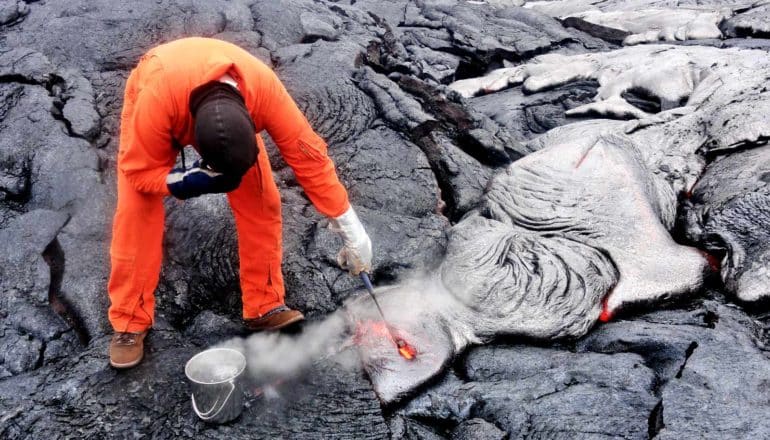
Magmas are surprising wet, new research finds.
Volatile elements in magma, primarily water, drive explosive volcanic eruptions. The tricky part is determining just how much volatile content was present before the eruption took place. This is especially difficult when the only evidence scientists have to go on is the end product after all the volatiles have been lost.
The most common method for determining volatile content requires studying melt inclusions, small pieces of magma trapped in crystals erupted in lava. Scientists study these glassy inclusions to determine the amount of hydrogen present—which, through back calculation, can indicate how much water was dissolved in the magma in Earth’s crust before a volcano erupted. This method is generally accepted as an accurate lower limit on volatile content, accounting for some water that might have been lost during the explosion itself.
The researchers instead wanted to look at the upper limit—something that had not been investigated experimentally.
“What people have never looked at before and what we’re trying to measure now is, how big is this bucket?” says study leader Michael J. Krawczynski, assistant professor of earth and planetary sciences at Washington University in St. Louis. “You can imagine if it rained a lot, and your rain gauge was full, then you don’t really know how much it rained. It could have rained more! We just can’t say.”
The same is true of melt inclusions. If a melt inclusion can’t hold all the water, then scientists don’t have the right reading of the upper limit of water content in magma. The bucket is too small.
Quenching to form glass
Maxim Gavrilenko, a former postdoctoral fellow in Krawczynski’s lab who is now at the University of Nevada, Reno, and Krawczynski created synthetic melt inclusions in the lab to figure out how much water a melt possibly could hold. To do this, the researchers reproduced the temperature and pressure conditions that exist 40 kilometers (about 25 miles) below the Earth’s surface.
Next, they melted and quenched (rapidly cooled) the sample, then determined whether their experiment had created a glass. They continued the process, adding more and more water to the sample until it could no longer be quenched to form a glass.
“We found out that if you have a lot of water, then eventually you don’t have a glass,” Gavrilenko says. These devitrified (non-glassy) melt inclusions exist in nature, but are preferentially not studied for volatiles—which has led to sample bias in this field of research.
Subducting water
This bias is especially problematic for scientists who are trying to understand how much water gets recycled back to the surface at subduction zones, which are richest in water compared to other tectonic settings.
“If the deep magmas in these zones have more than 9 weight-percent of water, then they won’t be correctly measured by the current gold-standard method,” Gavrilenko says. “There is a need to find a new method for how to measure. We need a new, bigger bucket.”
These results, published in American Mineralogist, align with recent work by Douglas A. Wiens, professor in earth and planetary sciences. In a paper in Nature last fall, Wiens concluded that as much as four times more water might subduct into Earth’s mantle than scientists thought. Gavrilenko and Krawczynski’s work points to how the cycle of water in and out of the crust might be rebalanced in the wake of such discoveries.
“If more is going down (into the mantle), more needs to be coming out back into Earth’s crust,” Krawczynski says. “That’s what we’re looking at here. We’ve understood that it’s a cycle that needs to be balanced, but we haven’t had a good grasp of the sizes of the different reservoirs.”
Source: Shawn Ballard for Washington University in St. Louis
The post Magmas can hold a surprising amount of water appeared first on Futurity.
from Futurity https://ift.tt/2Yz4kJL
No comments:
Post a Comment